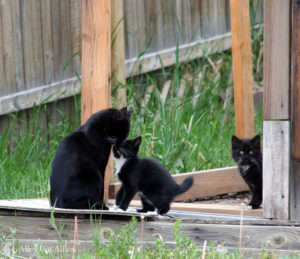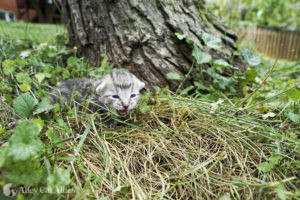TNR Scenarios: Mom and Kittens
 Discovering a mom and her kittens during Trap-Neuter-Return (TNR) can be an adorable yet challenging experience (mostly adorable). There are some important factors to consider in this scenario, like:
Discovering a mom and her kittens during Trap-Neuter-Return (TNR) can be an adorable yet challenging experience (mostly adorable). There are some important factors to consider in this scenario, like:
- Should you leave mom with her kittens?
- Are the kittens old enough to separate from mom?
- What if you find kittens without mom?
- How can you safely trap mom and kittens at the same time?
Don’t worry, we’ve got the information you need!
First, it’s important to determine how old a kitten is so you can decide how to best help her.
- For a kitten younger than eight weeks, the best place for her is with her mother.
- For a kitten who weighs at least two pounds and is eight weeks old, consult with a veterinarian to determine when to spay or neuter.
Make decisions carefully. Caring for kittens under four weeks old, or neonatal kittens, is not a choice to take lightly. These kittens need special round-the-clock care, and their mom is their best possible caregiver. Be very, very sure any neonatal kittens you find outdoors do not have a mother before choosing to take action. It takes quite a lot of time and resources to care for neonatal kittens yourself.
Never take cats or kittens to an animal shelter. Many shelters still kill the majority of cats they impound
With these basics in mind, here are some tips on how to approach common kitten and mom scenarios:
Neonatal Kittens WITHOUT Mom
 Always wait to see if mom returns. Watch for a few hours from a distance or a hidden spot. Even if mom doesn’t seem to be around, she may just be out looking for food or taking a break. She may even be hiding and waiting for YOU to leave!
Always wait to see if mom returns. Watch for a few hours from a distance or a hidden spot. Even if mom doesn’t seem to be around, she may just be out looking for food or taking a break. She may even be hiding and waiting for YOU to leave!
Has mom not returned after several hours? Step in and help the kittens yourself. You can also do the same if you determine that the kittens are in immediate danger. By “immediate danger”, we mean if the kittens are injured, look like they are not moving, or if the area they are in is deadly hot or cold or about or be destroyed by natural dilapidation, disaster, or construction.
If you have the resources and ability to care for neonatal kittens yourself, you can do so. Alley Cat Allies has a guide to help and a list of things you need in a kitten care kit.
- If you are unable to care for neonatal kittens yourself DO NOT take them to an animal shelter. See if a friend or family member can care for them, or contact local rescues, animal protection groups, or advocates. You may be able to find such advocates in your area through Alley Cat Allies’ Feral Friends Network.
- Does your shelter have a Wait Until 8® program? Through this innovative program, animal shelters empower good Samaritans who find kittens to care for those kittens at home. The shelter provides tools and instructions, like kitten care kits, to ensure a kitten’s caregiver has everything they need. When the kittens are eight weeks old, they come back to the shelter to be spayed or neutered and entered into the shelter’s adoption program. Call or visit and ask your local shelter if they have this program in place. If not, we encourage you to ask your shelter leaders to adopt the program.
Once the kittens are over eight weeks old, you can have them safely spayed or neutered at a veterinary clinic. Then, you can…Foster and adopt the kittens. If you have the time and resources, you can foster the kittens for adoption, or adopt them yourself, once they have been spayed or neutered. Otherwise, find a local rescue organization or another caregiver to foster and adopt the kittens. Do NOT bring them to an animal shelter.
If kittens have been indoors at their most critical growth ages before 8 weeks of age, do not return them outdoors. They will not have developed the skills to live as a community cat if they were raised away from their mother outside of their outdoor environment.
Neonatal kittens WITH mom
Leave neonatal kittens with their mother outdoors. Mom is kittens’ best caregiver. Provide food, water, and shelter, and monitor the family daily.
Wait until the kittens are over eight weeks old. This is the age when they are usually weaned from their mother and can be separated from her. Then, you have a new decision to make…
- Let kittens continue to live outdoors as community cats. The kittens were already fine and at home outdoors, so they can thrive there with their mother. Once they are at least two pounds or eight weeks old, have them spayed or neutered through a TNR program.
- Foster and adopt out the kittens. If you have the resources, you can separate kittens over four weeks old from their mother and bring them indoors to socialize them for adoption.
- Either way, spay mom. Mom cat should be spayed as part of a TNR program and returned to her outdoor home regardless of what decision you make for the kittens.
- What if mom is friendly? You can still TNR mom if she is friendly, or socialized, to people. If you have the time and resources, you may consider fostering and adopting her out. But returning her outdoors is also fine.
What if kittens and mom are in danger? In rare extreme cases, you may determine that it is safer for both mom and kittens to come indoors. These cases include if they appear to need medical attention or if the environment will cause immediate harm to the kittens or is about to be destroyed.
- Under these circumstances, bring the whole family inside to a quiet, small room (like a bathroom). You can also use a large dog crate, covered with a blanket.
- Provide the mother cat and kittens with a carrier as a hiding place, food and water, and a litter box placed as far away from the sleeping and eating area as possible.
- You can decide to foster the kittens for adoption or return them to their original outdoor home as soon as it is safe, or the family is healthy again. HOWEVER, if the kittens have been raised indoors for a significant amount of time, as in weeks, we don’t typically recommend returning them and instead recommend providing spay or neuter when they are 8 weeks old and finding them adoptive homes.
- If you believe the cats’ original environment will never be safe for them, you can potentially find a new outdoor home where they can live. Remember: Relocation is an absolute last resort.
Other Scenarios
- Older kittens. If you find kittens outdoors who are over eight weeks old, have them spayed and neutered immediately.
- Alley Cat Allies does not, in general, recommend trying to socialize a feral cat over 4 months of age. However, there is a gray area in which the personality of the individual cat comes into play. Between 4 and 8 months of age, if there is time and capacity and if the kitten is showing meaningful signs of social behavior, the decision may be made to place the kitten in a foster home for socialization and eventual adoption.
- Keep in mind that socializing is time-consuming, especially for older kittens. It involves interacting with the kittens one-on-one for at least a couple of hours every day, and results are not guaranteed. It is important to do an honest assessment of the kitten’s progress during this time. If she does not show increasing signs of socialization within a week or so, it is best that she is returned to her colony outdoors through TNR. To do otherwise is to expose the kitten to ongoing stress. Kittens will be safe and healthy in their outdoor homes with their feline families.
- Nursing moms. If you trap a nursing mother cat during TNR, you may not realize it until you are at the veterinary clinic. However, this may be the only opportunity you have to spay her. Move forward with the procedure and then return her to the outdoor area you found her as soon as possible so she can reunite with her kittens. Don’t worry, mother cats continue to produce milk even after being spayed.
- Be sure to speak with the veterinarian to let them know of your plans to return the nursing mother as soon as possible so they can adjust their schedule or procedures.
- Socialized moms. Even a friendly community cat mother can still thrive outdoors and will benefit from being part of a TNR program. However, if you have the time and resources to socialize both mom cat and her kittens and adopt them out, you can do so.

